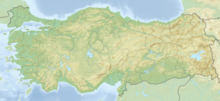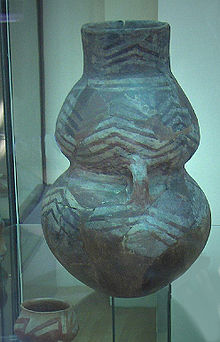Hacılar Höyük
Coordinates: 37 ° 35 ′ 4 ″ N , 30 ° 5 ′ 5 ″ E
Hacılar Höyük (usually referred to as Hacılar for short ) is an archaeological site in southwestern Turkey , about 25 km from Burdur .
In Hacılar, the remains of a Neolithic and Copper Age village have been excavated. The little tell was about 5 m high and 150 m wide. Excavations took place from 1957 to 1961 by James Mellaart . The oldest layers belong to the pre-ceramic Neolithic and date to the eighth millennium BC. Nine layers can be assigned to the 6th millennium, the oldest of them containing almost only undecorated ceramics. Layer VI, which dates from around 5600 BC. Dated is best researched. There were nine adobe buildings that were grouped around a square. The basis of life was agriculture ( emmer , einkorn , common wheat , barley , peas and vetch) and cattle breeding, there were bones of cattle, pigs, sheep, goats and dogs. The pottery is simple, some elaborate specimens reproduce animals. Numerous clay figures of naked women are remarkable.
From layer V colored ceramics appear. From then on, vessels are partially decorated with geometric patterns. In Layer II (around 5300 BC) the village was fortified and had a small temple. The Layer I settlement, which dates from around 5000 BC. Dated to BC, differs significantly from the earlier strata, and it is believed that newcomers settled here. The place is now strongly fortified. The ceramic is very well made and mostly painted red on white.
literature
-
James Mellaart : Excavations at Hacilar. University Press, Edinburgh 1970:
- Excavations at Hacilar (main volume ) (= British Institute of Archeology, Ankara. Occasional publications , No. 9). ISBN 0-85224-067-8 (English).
- Excavations at Hacilar. Plates and figures (= British Institute of Archeology, Ankara. Occasional publications , No. 10). ISBN 0-85224-170-4 (English).
- Refik Duru (Ed.), Suna-İnan Kıraç Akdeniz Medeniyetleri Araştırma Enstitüsü (Ed.): From 8000 BC to 2000 BC. Six thousand years of the Burdur-Antalya region (= Monography series , Volume 4). Vehbi Koç Vakfı, Antalya 2008, ISBN 978-6-05-002702-0 (English).

